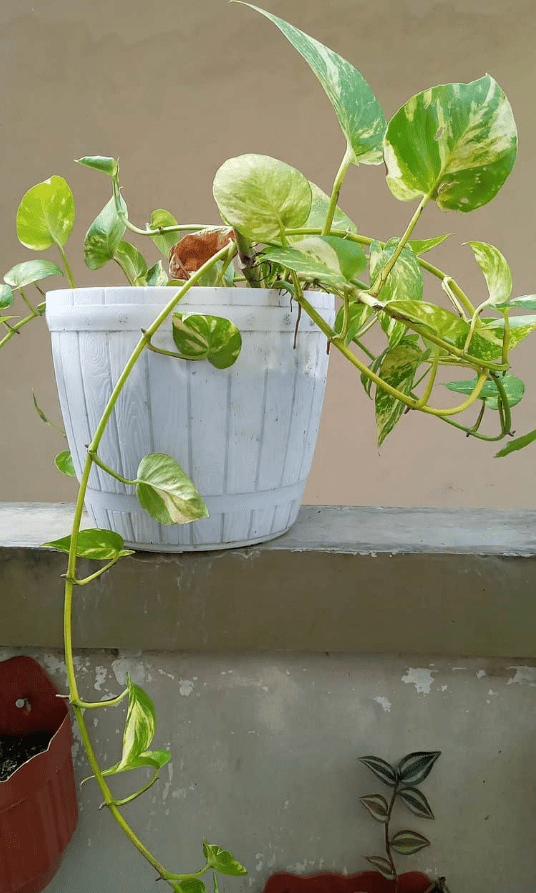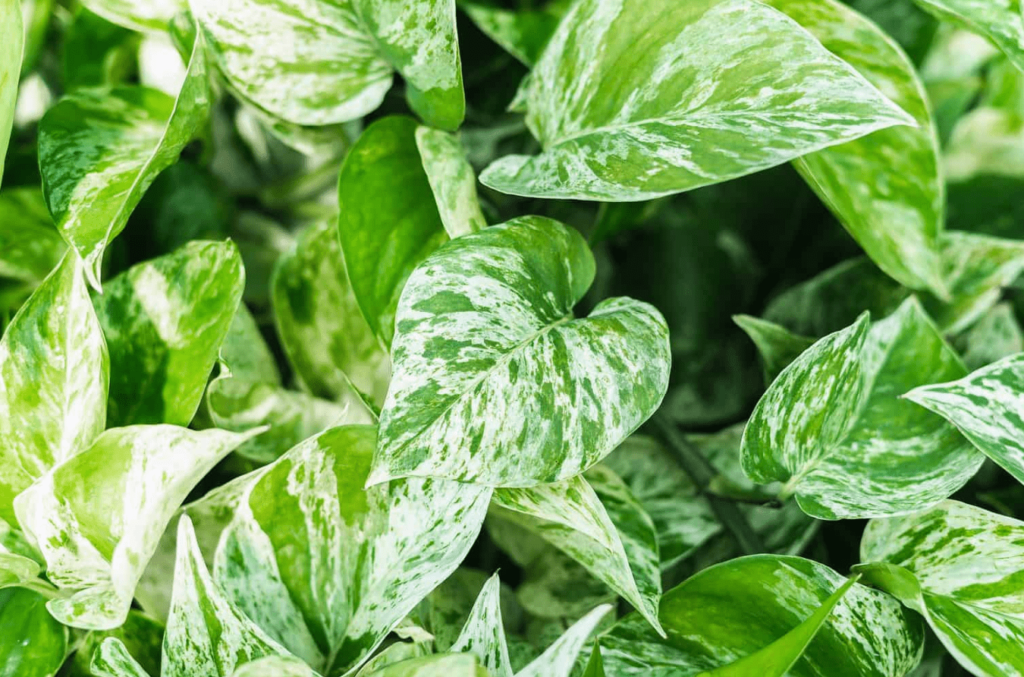The Jessenia pothos plant is the newest form of the beloved Epipremnum aureum species. This plant has become increasingly popular among plant collectors and ornamental plant lovers in recent years. Because it is durable and has a bright green marble pattern. Due to its resilience and ability to withstand harsh conditions, the Pothos plant is also known as the money plant or devil’s ivy. Therefore, it is one of the most popular vines to grow indoors. Simply put, this common tropical houseplant has a beautiful marbled variety in Jessenia pothos. We will discuss the planting, cultivation, and care of Jessenia pothos in this guide. We’ll also cover some important details about this unique little plant.
Table of Contents
What is the Jessenia Pothos?

One form of Epipremnum aureum known as pothos, Jessenia pothos, is a member of the plant family Araceae, belonging to the Epipremnum aureum group “Jessenia.” Due to the different diversity They have a deeper and brighter lemon color than the usually yellow or pale varieties. This low-maintenance tropical houseplant can survive indoors for up to ten years. It likes bright, indirect light. Compared to other Pothos varieties, this Pothos variety is smaller as it can grow up to 10 feet long. USDA hardiness zones 10 to 12 allow it to be grown outdoors. This colorful variety, similar to Golden Pothos, was introduced by Costa Farms in 2014 and has been very popular ever since. The popular Marble Queen Pothos is the ancestor of the Jessenia pothos variety. All of these domesticated species originate from the wild Epipremnum aureum. which is mostly found in tropical Southeast Asia. Pacific Islands and Australia This plant is very easy to grow indoors for gardeners of all ages and skill levels. This plant does not require much care and can survive for a long time without watering. It may grow like a weed and thrive with little fertilizer. If you want to add a touch of color to your interior design but don’t have time to care for houseplants, Jessenia pothos may be the right plant for you.
How to Care for Jessenia Pothos
Like other Pothos plants, Jessenia pothos is widely known for being hardy and easy to grow. to maintain diversity. It grows more slowly and requires more light than other plants whose colors are not slightly different, such as the golden pothos. Like other Pothos varieties, Jessenia pothos likes to be watered when the top two or three inches of soil are dry. On the other hand, this plant is known to be quite drought tolerant and can withstand water shortages from time to time. Reduce watering frequency when the plant is dormant. In autumn and winter when the trees are not growing. Jessenia pothos originates from tropical rainforests. Likes warm and humid weather. This plant should be kept in a climate between 65 and 75 degrees Fahrenheit. and humidity is between 50% and 70% for this plant, temperatures below 50 degrees Fahrenheit can be dangerous. This colorful plant grows best in bright, indirect light. But it can handle low or medium light quite well. Unlike other varieties, Jessenia pothos should not be planted in low light conditions because it will lose its variegation. If this beautiful species lost all its bright stripes and spots, what good would it do? Direct sunlight should also be avoided because it can burn the plant leaves. Jessenia pothos requires a soil mix that holds water and has good drainage. It is best to use a mixture of potting soil, perlite, and bark to provide good drainage and aeration. However, clean potting soil will help preserve this plant for a while. Fertilization should be continued throughout the growing season to encourage slow growth of Jessenia pothos. Water this plant once a month in spring and summer. and fertilizing with balanced liquid fertilizer. Do not fertilize at all during fall and winter. All types of Pothos can die quickly from over-fertilization.
How to Propagate Jessenia Pothos
The most effective way to propagate Jessenia pothos is through cuttings. Cuttings are simply divided plant parts rooted in water or a moss-based mixture. You can get several baby pothos plants by taking cuttings from Jessenia pothos vines if you support the young shoots well while they root and leave enough nodes. You’ll have new plants in no time. On Pothos plants, nodes are brown bumps that connect the leaves to the stem. New roots and leaves from the cutting will grow from the joint. First, use sharp, sterile scissors that have been cleaned with diluted alcohol. In short, This will ensure that you do not spread any disease. to your existing plant Find the long, strong vines on your Jessenia pothos, then count three or four leaves from the tip of the vine. Make sure there are still two or three knots visible above the cut. After removing the bottom two leaves, place the cut leaves in a jar filled with water so that the bottom segments are completely submerged. The mother plant can be kept in the same conditions that the mother plant in this jar prefers: a warm location with soft, indirect light and neither too bright nor too dark. within a few weeks you will see roots emerging from the wounds on the stem. Many plant collectors wait until the cuttings have had at least a month for the roots to fully spread before planting them in the ground. The cutting should have about 2-4 inches of roots that have begun to branch out. After adding potting soil to the container Place the newly rooted branch carefully into the soil mixture. and take root when you add soil Be careful not to press the mixture as your seedlings need lots of air flow to the roots. After watering the transplant thoroughly Treat it as you would any other pot!
How to Identify Jessenia Pothos

If you want to buy Jessenia pothos, it is important to distinguish it from other types of pothos that look like this. This variety is often mislabeled at nurseries and online retailers. Because they are so similar to other species, it is important that you have information to ensure you are purchasing genuine gessenia. Marble Queen Pothos, the parent plant of Jessenia pothos, is the same. The main difference between the two is the lime green color of Jessenia. Although the color of the Marble Queen Pothos is usually much lighter, with a creamy hue, some Jessenia leaves also have distinctive forest green and lime swirls, spots, and stripes that resemble green stains. Jessenia is sometimes confused with golden pothos, which is often called the “basal” variety of Epipremnum aureum. Although gold and lime green are definitely gold in color, Jessenia Pothos sticks to lime and forest green, like other marbled plants or varieties. They often develop more slowly than golden or jade pothos, primarily because the lighter colored leaves contain less chlorophyll. This reduces photosynthetic ability. The heart-shaped leaves and turquoise spots make Jessenia pothos even more attractive to ornamental plant lovers. Although the growth is slower. Strong, indirect light will bring out the bright colors of the Jessenia pothos plant’s leaves. Lower light levels will make the leaves appear darker and the variations less visible.
Common Jessenia Pothos Problems
Under normal circumstances, Jessenia pothos usually does not cause headaches. If pests, root rot, or leaves are a problem, you can use simple techniques. There are many reasons. The two main pests that cause damage to Pothos plants inside are mealybugs and gnats. This annoying problem can be solved by using neem oil. Simply dilute neem oil with water and rub the neem directly onto the surface of the leaves with a damp cloth. By doing this, you will remove existing insects and prevent new ones from forming. If you plant Jessenia pothos in dense soil or water it too much, this will make the roots rot more easily. This can cause the leaves to turn yellow and stop growth. To overcome these problems, the pot should be moved to a new container where the soil drains more easily. Sometimes older jessenia leaves turn yellow and eventually die. However, if you often notice a yellow or brown color, there may be a more serious problem. Bleeding and discoloration can be caused by too much water. Leaves that don’t get enough water may start to look brittle or burnt. Leaf scorch caused by too much light looks like this. Has sunburn spots and darker color. Leaves that don’t get enough light can turn yellow or change color. All of these problems can be overcome by improving soil conditions. Careful attention to watering and moving the plant to a location that gets more sunlight.
Do Jessenia Pothos Grow Flowers?
It is true that adult Jessenia pothos can flower. Pothos flowers are generally spade-shaped and cream or white in color, but Pothos grown as houseplants almost never flower and are rarely as large as wild Pothos; On the contrary, they almost always remain in a young state. However, the stunning foliage of Jessenia pothos compensates for the lack of flowers. So it’s not too much of a concern.
Are Jessenia Pothos Toxic to Pets?
All poisons can poison humans, dogs, and cats. It is best to store it on a shelf or hanging basket out of reach of children and pets. Eating or chewing this plant can cause nausea, vomiting, diarrhea, and swelling of the lips or throat. Burning or itching in the mouth and contact dermatitis Fortunately, Jessenia pothos is easy to keep away from animals and small children. and likes to wrap around trellises or any type of structure. A great variety of Pothos to add to your collection is Jessenia Pothos, perfect for those who want to enjoy colorful pothos. But I wanted a bright lime green pattern. rather than the typical white and silver design. One unique variety that can brighten up any room is Jessenia pothos!

